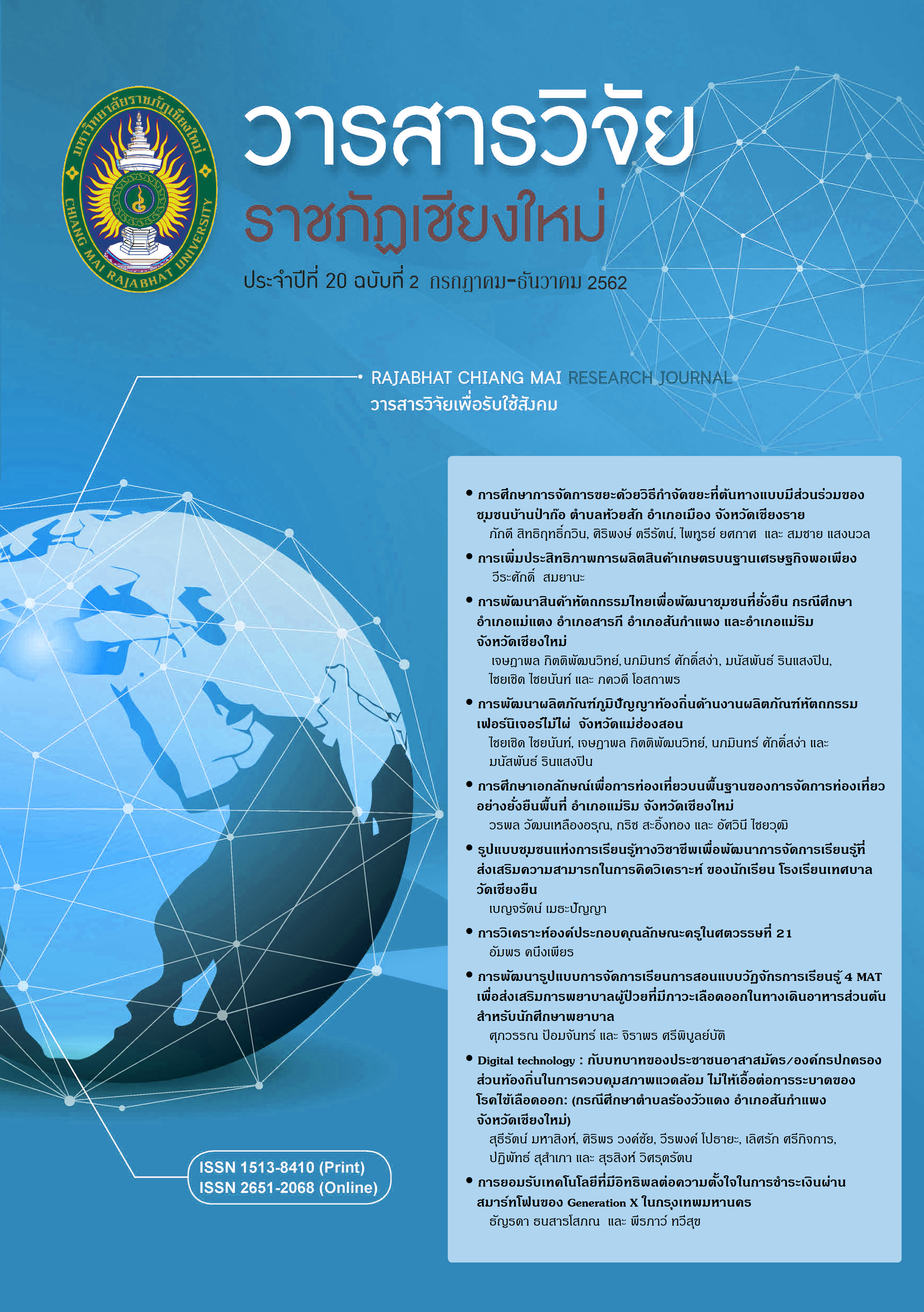การวิเคราะห์องค์ประกอบคุณลักษณะครูในศตวรรษที่ 21
DOI:
https://doi.org/10.14456/rcmrj.2019.205538คำสำคัญ:
วิเคราะห์องค์ประกอบ, คุณลักษณะครู, ศตวรรษที่ 21บทคัดย่อ
การวิจัยนี้มีวัตถุประสงค์ 2 ข้อ คือ 1) เพื่อวิเคราะห์องค์ประกอบคุณลักษณะครูในศตวรรษที่ 21 โรงเรียนสุรวิทยาคาร และ 2) ตรวจสอบความสอดคล้องของโมเดลกับข้อมูลเชิงประจักษ์ กลุ่มตัวอย่างที่ใช้ในการศึกษาครั้งนี้ ได้แก่ ครูผู้สอน นักเรียน ผู้ปกครองและคณะกรรมการการศึกษาขั้นพื้นฐาน ของโรงเรียนสุรวิทยาคาร ภาคเรียนที่ 2 ปีการศึกษา 2560 จำนวน 691 คน เครื่องมือที่ใช้ในการวิจัยเป็นแบบสอบถามเรื่องคุณลักษณะครูในศตวรรษที่ 21 แบ่งเป็น 2 ตอน ตอนที่ 1 เป็นแบบสอบถามข้อมูลทั่วไปของผู้ตอบแบบสอบถาม ตอนที่ 2 แบบประเมินคุณลักษณะครูในศตวรรษที่ 21 เป็นแบบมาตรวัดประมาณค่า 5 ระดับ จำนวน 12 องค์ประกอบ 82 ตัวแปรสังเกตได้ ผลการวิจัยสรุปได้ดังนี้
1. ผลการวิเคราะห์องค์ประกอบเชิงยืนยันอันดับหนึ่งเพื่อตรวจสอบความตรงเชิงโครงสร้างพบว่ามีจำนวน 12 องค์ประกอบ ได้แก่ องค์ประกอบด้านการใช้นวัตกรรมและเทคโนโลยี องค์ประกอบด้านการมีจิตวิญญาณความเป็นครู องค์ประกอบด้านการมีบุคลิกภาพที่ดี องค์ประกอบด้านทักษะในการสื่อสาร ด้านความเชี่ยวชาญ องค์ประกอบด้านการวัดและประเมินผล องค์ประกอบด้านการพัฒนาหลักสูตร องค์ประกอบด้านการจัดบรรยากาศเพื่อการเรียน องค์ประกอบด้านการให้บริการ องค์ประกอบด้านพัฒนาตนเอง องค์ประกอบด้านความร่วมมือ และองค์ประกอบด้านการเป็นผู้นำ มีน้ำหนักองค์ประกอบเป็นบวก มีความตรงเชิงโครงสร้าง
2. ผลการวิเคราะห์องค์ประกอบเชิงยินยันอันดับสอง พบว่า โมเดลมีความกลมกลืนกับข้อมูลเชิงประจักษ์โดยมีค่าค่าไคสแควร์ = 5849.318 , DF = 2173, P = 0.00, GFI = 0.815, AGF = 0.724, NFI=0.902, IFI=0.936, CFI= 0.935, TLI=0.905, RMSEA = 0.050
Downloads
เอกสารอ้างอิง
กัลยา วาณิชบัญชา. (2557). การวิเคราะห์สมการโครงสร้าง (SEM) ด้วย AMOS . กรุงเทพฯ: ศูนย์หนังสือแห่งจุฬาลงกรณ์มหาวิทยาลัย.
จิรยา ภูพันนา และคณะ. (2556). คุณลักษณะของครูคณิตศาสตร์ในยุคศตวรรษที่ 21 ที่นักเรียนต้องการ . รายงานการวิจัย. มหาวิทยาลัยมหาสารคาม.
นพดล สร้อยนาค. (2551). คุณลักษณะที่พึงประสงค์ ของครูในทรรศนะของผูปกครองใน ตำบลแม่สาบ อำเภอสะเมิง จังหวัดเชียงใหม่. วิทยานิพนธ์ครุศาสตร์มหาบัณฑิต สาขาบริหารการศึกษา มหาวิทยาลัยราชภัฏสวนดุสิต.
ปรีชา ทดแทน. (2553). คุณลักษณะของครูที่พึงประสงค์ ตามการรับรู้ของนักเรียนชั้นประกาศนียบัตรวิชาชีพ โรงเรียนจอมเทียนบริหารธุรกิจ. งานนิพนธ์ปริญญาการศึกษามหาบัณฑิต สาขาการบริหารการศึกษา มหาวิทยาลัยบูรพา.
พิณสุดา สิริรังธศรี. (2557). การยกระดับครูไทยในศตวรรษที่ 21. พิมพ์ครั้งที่ 1. กรุงเทพฯ บริษัทมาตาการพิมพ์จำกัด.
ลัดดาวัลย์ สืบจิต. (2556). การพัฒนาตัวบ่งชี้สมรรถนะครูในศตวรรษที่ 21 สำนักงานคณะกรรมการการศึกษาขั้นพื้นฐาน. ปริญญานิพนธ์ดุษฎีบัณฑิต การบริหารการศึกษา มหาวิทยาลัยราชภัฏมหาสารคาม.
สำนักงานคณะกรรมการการศึกษาขั้นพื้นฐาน. (2553). คู่มือการประเมินสมรรถนะครู. กรุงเทพฯ. สำนักงานคณะกรรมการการศึกษาขั้นพื้นฐาน.
สำนักงานเลขาธิการคุรุสภา. (2556). มาตรฐานวิชาชีพครู. กรุงเทพฯ: สำนักมาตรฐานวิชาชีพสำนักงานเลขาธิการครุสภา.
สุเทพ ธรรมตระกูล และอนุวัติ คูณแก้ว. (2555). การศึกษาคุณลักษณะของครูยุคใหม่. รายงานการวิจัย. มหาวิทยาลัยราชภัฏเพชรบูรณ์.
สุพรทิพย์ ธนภัทรโชติวัต. (2556). การพัฒนารูปแบบการจัดประสบการณ์วิชาชีพครูเพื่อส่งเสริมคุณลักษณะครูในศตวรรษที่ 21. วิทยานิพนธ์ปริญญาการศึกษาดุษฎีบัณฑิต สาขาหลักสูตรและการสอน มหาวิทยาลัยนเรศวร.
Andrew Churches. (2008). Bloom's Digital Taxonomy. Retrieved from http://burtonslifelearning.pbworks.com/f/BloomDigitalTaxonomy2001.pdf
Hafsah Jan. (2017). Teacher of 21st Century: Characteristics and Development. D Scholar, School of Education & Beharioural Sciences, University of Kashmir.
ดาวน์โหลด
เผยแพร่แล้ว
รูปแบบการอ้างอิง
ฉบับ
ประเภทบทความ
สัญญาอนุญาต
1. บทความ ข้อมูล เนื้อหา รูปภาพ ฯลฯ ที่ได้รับการตีพิมพ์ใน “Community and Social Development Journal” ถือเป็นลิขสิทธิ์ของ Community and Social Development Journal มหาวิทยาลัยราชภัฏเชียงใหม่ และเพื่อให้เผยแพร่บทความได้อย่างเหมาะสมผ่านสื่อสิ่งพิมพ์และอิเล็กทรอนิกส์ ผู้เขียนยังคงถือครองลิขสิทธิ์บทความที่ตีพิมพ์ภายใต้ใบอนุญาต Creative Commons Attribution (CC BY) ซึ่งอนุญาตให้เผยแพร่บทความซ้ำในแหล่งอื่นได้ โดยอ้างอิงต้องอ้งอิงบทความในวารสาร ผู้เขียนต้องรับผิดชอบในการขออนุญาตผลิตซ้ำเนื้อหาที่มีลิขสิทธิ์จากแหล่งอื่น
2. เนื้อหาบทความที่ปรากฏในวารสารเป็นความรับผิดชอบของผู้เขียนบทความโดยตรง ซึ่งกองบรรณาธิการวารสารไม่จำเป็นต้องเห็นด้วยหรือร่วมรับผิดชอบใดๆ














